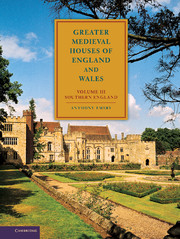Book contents
- Frontmatter
- Contents
- Acknowledgements
- List of abbreviations
- Introduction
- PART I THE THAMES VALLEY
- PART II LONDON AND SOUTH-EAST ENGLAND
- 6 London: an introduction
- 7 London: bibliography
- 8 London: survey
- 9 South-east England: historical background
- 10 South-east England: architectural introduction
- 11 The impact of the Hundred Years' War on English domestic architecture
- 12 South-east England: bibliography
- 13 South-east England: survey
- Appendix 3 London and south-east England castles: residential additions
- Appendix 4 London and and south-east England: residential licences to crenellate
- PART III SOUTH-WEST ENGLAND
- Appendix 5 Castles of south-west England: residential additions
- Appendix 6 South-west England: residential licences to crenellate
- Appendix 7 The architectural value of John Leland and the Buck brothers
- List of plates
- List of figures
- Index
- Index of houses in volumes I, II and III
10 - South-east England: architectural introduction
from PART II - LONDON AND SOUTH-EAST ENGLAND
Published online by Cambridge University Press: 05 June 2012
- Frontmatter
- Contents
- Acknowledgements
- List of abbreviations
- Introduction
- PART I THE THAMES VALLEY
- PART II LONDON AND SOUTH-EAST ENGLAND
- 6 London: an introduction
- 7 London: bibliography
- 8 London: survey
- 9 South-east England: historical background
- 10 South-east England: architectural introduction
- 11 The impact of the Hundred Years' War on English domestic architecture
- 12 South-east England: bibliography
- 13 South-east England: survey
- Appendix 3 London and south-east England castles: residential additions
- Appendix 4 London and and south-east England: residential licences to crenellate
- PART III SOUTH-WEST ENGLAND
- Appendix 5 Castles of south-west England: residential additions
- Appendix 6 South-west England: residential licences to crenellate
- Appendix 7 The architectural value of John Leland and the Buck brothers
- List of plates
- List of figures
- Index
- Index of houses in volumes I, II and III
Summary
THREE factors distinguish the greater houses of the south-east from those of central and south-west England. The first is the large number of episcopal residences in the region. Even leaving those of London to one side, they contribute nearly a third of the properties covered in the detailed survey. The second is the paucity of major secular houses in Surrey and Hampshire and the limited number in Kent and Sussex. The third is the response across the region to the fear of French attack and possible invasion during the last quarter of the fourteenth century, and this is considered in detail in the essay that follows.
EPISCOPAL RESIDENCES
The spread and survival of episcopal palaces in England and Wales is patchy but the south-east retains a greater range in extent and quality than in any other part of the country. The political standing of the archbishop of Canterbury was of major significance through-out the middle ages. The relative wealth of his diocese and its position astride one of the key routes between London and Europe are at variance with its comparatively modest size. More than ten roofed properties survive, ranging from palace and castle to country houses, plus some ruined buildings and lost but documented residences. The diocese of Winchester is close on Canterbury's heels numerically and qualitively, with the benefit of even greater financial resources throughout the middle ages. Nine properties can still be examined, five roofed and four in ruin, plus the well-documented loss at Highclere. The see of Chichester is represented by residences at Chichester and Amberley, while the bishop of London's country house at Nurstead retains half of its timber-framed hall of c.1314.
- Type
- Chapter
- Information
- Greater Medieval Houses of England and Wales, 1300–1500 , pp. 267 - 273Publisher: Cambridge University PressPrint publication year: 2006



